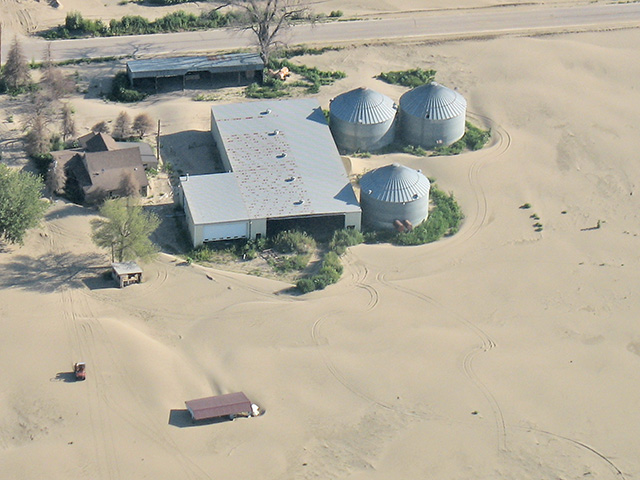Floods Hurt Basin Croplands
Federal Judge Considers Missouri River Flooding Compensation for Producers
OMAHA (DTN) -- Potential compensation for a handful of Missouri River Basin farmers who experienced repeated flooding over the years lies in the hands of a federal judge.
Based on post-trial briefs filed on behalf of the government and St. Joseph, Missouri, farmer Roger Ideker and two other farmers in recent days, those producers who claim property, crop and beneficial use losses on their land from repeated floods could receive tens of millions of dollars in compensation.
In early August, the second phase of a trial concluded in the U.S. Court of Federal Claims in Washington, D.C. Both sides submitted post-trial briefs just days ago.
Based on expert estimates filed in the plaintiffs' brief, Ideker could receive anywhere from about $23.9 million to $26.2 million in compensation for damage on his 1,493-acre tract of land.
But in a court brief also filed in recent days, the U.S. government questions the calculations used to determine compensation.
"The evidence presented in phase one and phase two make clear that plaintiffs have not met their burden to establish a taking," the government said in its brief. "The evidence also shows that the phase two plaintiffs' claims accrued more than six years before plaintiffs filed their complaint. And if the court finds that plaintiffs' complaint was timely and that there has been a taking, the evidence makes clear that plaintiffs' just compensation figures have been inflated every step of the way.
"The factual record in this case makes clear that to the extent the Corps' actions caused some flooding in certain years the Corps' actions did not cause all of the flooding. Indeed, all the evidence shows that the Corps caused only some incremental amount of additional flooding in certain years."
P[L1] D[0x0] M[300x250] OOP[F] ADUNIT[] T[]
In 2018, the court ruled the Corps was responsible for recurring floods that severely damaged Ideker's farm -- for several years post-2004, except 2011 -- and on March 11, 2019, the court moved to the compensation portion of the case. Ideker's farm was again underwater in 2019 as a result of the heavy flooding in the basin.
R. Dan Boulware, the lead attorney for Ideker Farms, told DTN the judge's ruling should be handed down this fall.
Ideker and hundreds of other basin farmers have been working to return large chunks of land buried in sand to production while holding out for a successful court case.
Exactly how much basin farmers will receive depends on where the judge comes down.
At the conclusion of the phase-two trial, both sides were far apart on the amount of compensation to award.
The lawsuit accused the Corps of Engineers of making changes to its flood manual that led to unprecedented releases from Gavins Point Dam in South Dakota following heavy spring rains and snowmelt in Montana in 2011. The Corps released large volumes of water from that dam in 2011, and all the levees along Ideker's farm were destroyed.
The federal government and a federal court sided with Ideker's claims that changes made to the Corps' flood manual in 2004 contributed to flooding on his farm prior to 2011. However, 2011 won't be included in the years eligible for compensation.
The 2011 flood caused an estimated $2 billion in damage in several states. The Corps had to make unprecedented water releases from northern dams, flooding farms and communities in the lower basin and bringing into question whether the Corps handled the situation correctly. Many landowners downstream blamed the Corps' water release for exacerbating the flood. A task force later found the Corps did all it could to manage the water.
Judge Nancy B. Firestone ruled in 2018 that, in five of the six years in question dating back to 2007, the Corps of Engineers violated the Takings Clause in the Fifth Amendment of the U.S. Constitution by not compensating farmers for flood-damaged land. She disallowed flood claims from 2011.
Firestone allowed the federal government to present new evidence to show the Corps of Engineers has implemented measures to reduce flood risks that occurred after 2014.
Firestone ruled in 2018 the Corps deprioritized flood control in 2004. In 2004, the Corps instituted the Missouri River Recovery Program to accelerate changes to the river to enhance wildlife habitats.
In her 259-page opinion in 2019, Firestone said evidence establishes the Corps' changes to the river "had the effect of raising the Missouri River's water surface elevations in periods of high flows."
The court found that, since 2007, flooding has been among the worst in the history of the river, and the Corps' changes in management either caused or contributed to the flooding.
In the summer of 2016, the U.S. Government Accountability Office issued a report saying the Corps is falling short on the system in place to update water-control manuals. Corps regulations state water-control manuals should be reviewed at least every 10 years.
Todd Neeley can be reached at todd.neeley@dtn.com
Follow him on Twitter @toddneeleyDTN
(c) Copyright 2020 DTN, LLC. All rights reserved.




